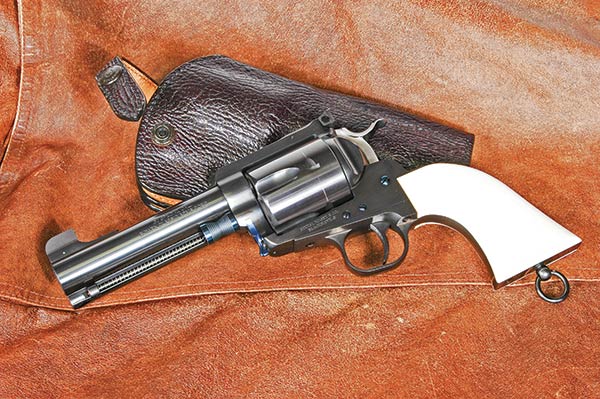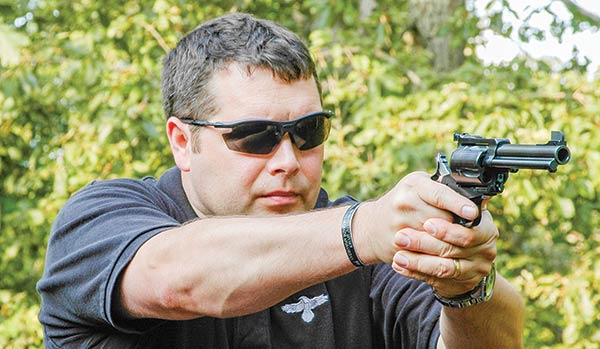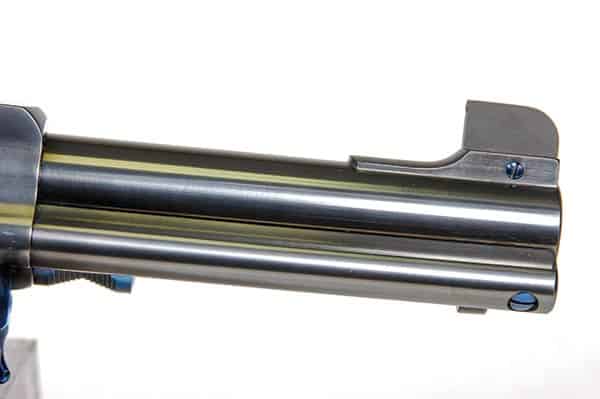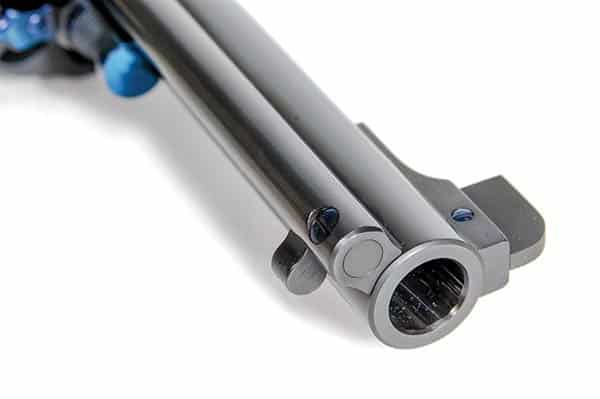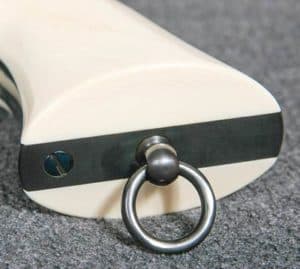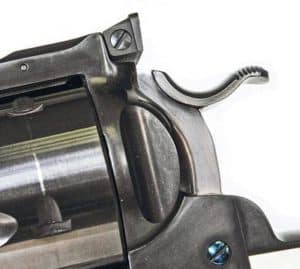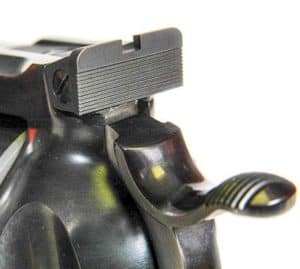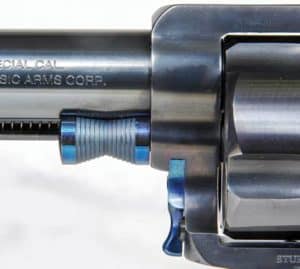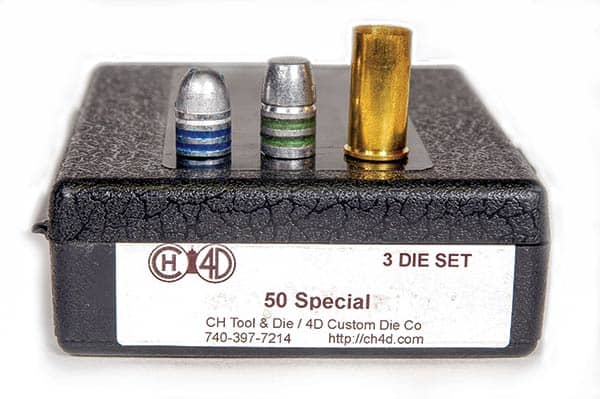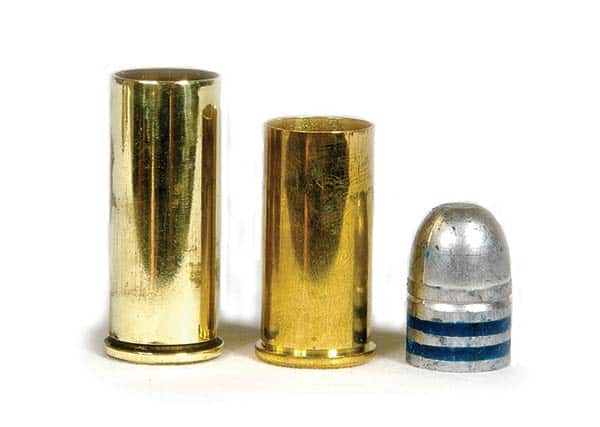Custom Compromise
.50 Special Super Blackhawk Bowen's
Magic Brings Power — Without Pay!
Linebaugh Understudy?
Enter Hamilton Bowen, the custom revolver maker who was one of the early ’smiths building the big Linebaughs in the days when you couldn’t just buy one off the shelf. Bowen likes to say there’s a Special hiding in every Magnum, and proved it when he shortened a .500 Linebaugh case to the same length as a .38 Special case (1.160″).
The resulting .50 Special throws a .511″ 350-gr. bullet at some 800 fps in its standard load. Hotter loads can push 400-gr. slugs north of 1,000 so the Special isn’t all sweetness and light. It’s got plenty of punch for whitetail or black bear, but is still surprisingly soft to shoot, even compared to hotrodded +P .45 Colt loads.
It also serves as a reduced load in guns chambered for the .500 Linebaugh, which doesn’t seem to care for the empty space left in the case with some reduced charges. As an added bonus, the low pressure at which the cartridge operates makes some things possible that you can’t do with calibers dead-set on breaking the middle finger of your shooting hand.
The Elmer Influence
My interest in the cartridge started with Bowen’s laugh-out-loud description of it in his book The Custom Revolver, including what must have been a spectacular failure of one to stop a ground squirrel. It didn’t take me long to make up my wish list from the rest of the modifications Bowen described, but it did take some years to save for the gun and an appropriate wait for it to be built.
After laying hands on a Ruger Super Blackhawk in .44 Magnum, I settled on Bowen’s Rough Country adjustable rear sight and a gold bead front, as well as a Bisley hammer and lightening cuts on the recoil shield and loading gate. Both the last modifications are connected to Elmer Keith’s legendary No. 5, which represented Keith’s view on how to keep the Colt SAA relevant as a fighting gun.
The Bisley hammer spur sits lower than the traditional SAA-style spur, permitting faster cocking. Cowboy Action shooters may disagree, but they typically use both hands to cock the gun, while those of us who carry a single action as bear medicine know one hand may be the best we can muster. So on went the lower hammer as well as perhaps the most distinctive feature of the No. 5 — the lever-style base pin latch.
SAA base pins are usually held in place with a spring-loaded cross-pin. The problem? Recoil can cause the base pin to jump the latch, moving forward enough to deactivate the transfer bar safety that makes Rugers go bang. Not good …
While Bowen uses a set screw and detent arrangement on his guns, Keith chose a complicated lever arrangement that pivots and turns — scissor-like — to latch the pin in place. The head of the pin itself has a large, distinctive hourglass shape so it can be easily removed, no matter how dirty the gun is.
Elegant and horribly expensive, installing the latch means the factory cross-pin hole has to be welded up, the frame re-machined and the latch parts fabricated and hand-fitted. It’s labor intensive, and because it involves so much cutting on the frame, it’s not suited to the big magnums. But with the .50 Special, no problem.
Left: The lanyard loop is a great way to keep from losing the gun. Second Left: The original hammer was replaced with a lower Bisley model that cocks easier when the gun is fired one-handed. Right: The stock rear sight was replaced with Bowen’s adjustable Rough Country. The rear blade is also interchangeable. Far Right: The Keith-style No. 5 basepin latch — along with the rest of the small parts — was finished in fire blue.
Coming To Grips
Building a Special also allows more flexibility in grip shape and material. There’s a reason most heavy caliber SA revolver grips use a Bisley shape. The original curved SAA grip tends to roll in recoil, and when you’re shooting something like a .475 Linebaugh, this looks a lot like going to the ER to get the hammer spur removed from the web of your hand!
The humpbacked Bisley, though, keeps the gun in place and the hammer safely away from your hand. Happily, the manageable recoil of the .50 Special lets you get away with the traditional SAA-style grip with its more graceful curve, and Bowen carefully fit a new Ron Power grip frame that allows the use of one-piece grips.
The carefully decked grip frame then went off to gripmaker Rob Rowen, a student of the legendary Roy Fishpaw. While everyone has their own tastes on such things, ivory is historically used on best-grade guns, and legally sourced ivory is all over 30 years old. While it’s not particularly fragile — think what the elephant used it for — I wouldn’t want to put it on a magnum-class big bore, but again, it’s fine on a .50 Special. Due to a government rule change that went into effect after this set was made, however, the interstate sale of ivory has been sharply restricted and Rowen no longer works in ivory.
Since it’s a shame to drill a hole through the middle of such a material, Rowen joined two blocks together to create the one-piece grips that are clamped in place by the front and rear grip straps. The end result is stunning: the creamy white panels with their distinctive crosshatched grain are mated seamlessly to the black frame, which is set off with fire blued small parts.
A Proper Rig
Such a pistol, of course, deserves good leather, and Galco supplied one of their exotic series holsters in black sharkskin sized for the big Blackhawk’s 4 5/8″ barrel. It comes with both a retention strap and tension screw as well as a sight track large enough to clear Bowen’s tall front sight without planing out strips of leather when you draw.
Available in other hides such as stingray, alligator and ostrich, it’s not just the leather that makes the exotic holsters special: the craftsmanship is impressive. From the double stitching holding the loops in place to the near-liquid edgework, the extra work that goes into them is obvious.
However, pretty is as pretty does, which brings us to shooting. My first time shooting the .50 Special from a modified Weaver, yielded a couple of inches at 25 yards or so, followed by an offhand group with three or four of the bullets about touching. The accuracy, however, should not be surprising; the five-shot cylinder is custom made and each of the chambers are line-bored through the front of the frame with the cylinder clamped in place, reducing the tolerances that occur when you make both parts separately and then put them together and hope for the best. It is, in fact, the same cylinder blank Bowen uses for the .500 Linebaugh, so it’s plenty capable of taking whatever you want to throw at it. Since there’s not a lot of vetted load data available for the .50 Special, I stuck with fairly conservative loads.
Gotta Roll Your Own
The .50 Special is a handload-only proposition, and a bit more involved than some. Based — like the Linebaugh — on a .348 Winchester rifle case, either .348 or Linebaugh brass can be cut to length or purchased from Ben Forkin. Bullets are 0.511″ and a bit harder to find than more common 0.500″ slugs, but 365-gr. cast lead round nose (LRN) bullets are available from Forkin and Hunters Supply offers a 425-gr. flat point bullet that’s better suited for hunting. For those who cast their own bullets (like my friend Steve Johnson who kindly sent me a bag of 450s) even more options appear.
Loading dies came from CH Tool & Die via Bowen Classic Arms. While I typically load on a Dillon 550, I wanted to take my time with the .50, and Brownells’ supplied a single-stage RCBS Rock Chucker as well as a Lee bullet sizing die, a critical piece of equipment that ensures your cast bullets aren’t too big for the bore. There are many suppliers online, but I’ve always had good luck with Brownells.
The Rock Chucker, of course, is a classic single stage that comes with a priming tool built into the press. Slide a Number 5 shellholder into place on the ram, screw in and adjust your dies, and you’re off to the races.
Bowen’s standard load is 10 grains of Unique and a CCI 300 primer under the 365-gr. LRN. Not wanting to get too far off the beaten path, I experimented a bit with Blue Dot and Trail Boss with 365-, 425- and 450-gr. bullets and wasn’t entirely content with the results. Blue Dot showed erratic velocities and blew clouds of unburned powder out the barrel, and Trail Boss, which is typically loaded to near capacity, showed excellent accuracy with the 425s but delivered velocities well below what I expected. I am also, however, a very cautious handloader. The best group was about 1½” at 25 yards, with three rounds through one hole.
The gun is a hoot to shoot. The hammer rolls back easily, with the cylinder locking solidly into place. The crisp trigger breaks at a hair over 3 lbs., the easily-visible .50 bullet hole appears where you wanted it in the target and the gun rolls back with just enough authority to let you know you’re shooting a .50.
But … I can still feel my hand when I’m done shooting.
More Information:
Bowen Classic Arms
http://www.bowenclassicarms.com
Ph: (865) 984-3583
Brownells, Inc.
https://www.brownells.com
Ph: (800) 741-0015
Forkin Custom Classics
Ph: (406) 547-2344
Galco International
https://www.galcogunleather.com
Ph: (800) 874-2526
Hunters Supply
http://www.hunters-supply.com
http://www.hunters-supply.com
Ph: (505) 716-4369
Rowen Custom Grips
http://rowencustomgrips.com
LLC, Ph: (703) 795-9894
Starline Brass, Inc.
https://www.starlinebrass.com
Ph: (800) 280-6660
